What Ever Became of the I-52? (And its Two Tons of Gold?)
Actually, we know what happened to the 356-foot-long, 2,500-ton Japanese submarine. It sank during a surprise attack by an Avenger bomber launched from the aircraft carrier USS Bogue, June 23, 1944. Faced with naval and air blockades that threatened to stifle Germany in WW II, Japan launched its secret C-3 type cargo submarine for transporting wartime raw materials to a naval base in Nazi occupied Lorient, France. Oh, and the gold? We’ll get to that in a moment.

Drawing of the vast size of a Japanese “I” boat like the I-52. Credit: Nat’l Archives
Unaware of the U.S.Navy and its Allies’ flair for intercepting messages, the Japanese proceeded with one of the most highly clandestine operations of the war. Cryptologists had broken the Imperial Japanese code that mapped the route of the I-52 from Kure, Japan, to a submarine base in German occupied Lorient, France. The I-52, with a crew of 99, was a cargo carrier loaded with 35 tons of military supplies and payment in gold to exchange for German wartime materials and advanced technology. But our forces became the “foxes in the hen house.” They laid in wait with coordinates of the route at their disposal, all gleaned from intercepts of the highly classified Japanese code. They also pinpointed the location of the I-52’s planned rendezvous with the U-530. But the Atlantic is big and the engagement, if it were to take place as planned, would be in the middle of the Atlantic Ocean, 800 miles south of the Azores.
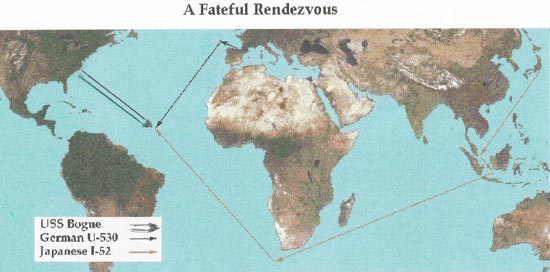
Map shows the rendezvous of the two submarines and the aircraft carrier, plus the route to France that the I-52 never completed. Credit: Paul Tidwell Photo/Copyright
The two submarines met at the designated spot and transferred a navigator, two radar operators and a new radar design that would help guide the I-52 to Lorient. But an uninvited guest—Commander Jesse Taylor—appeared on the scene in his Avenger, dropping a bomb and a torpedo that sent the enemy vessel straight to the bottom. Naval records reveal the U-530 slipped away in the night. Ironically, the munitions that struck and sank their target didn’t smash and scatter it all over the bottom as is often the case. The I-52 sits straight up on the seabed with a torpedo hole in its starboard side and minor damage to the bow. Its cargo remains intact. Does that mean the gold, listed on the manifest, was still inside the sub? We’ll get to that soon. The discovery of the I-52 is just as exciting as its demise.
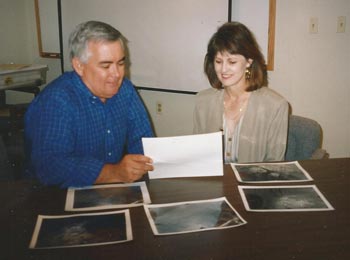
Paul Ttidwell and his wife, Joanne, previewing still photos of the I-52. Credit: Ellsworth Boyd
Paul Tidwell, who relocated to Jefferson, Texas, when Hurricane Katrina hit his hometown of New Orleans in 2005, had for years gathered thousands of pages of documentation on the I-52. He was so determined, he moved with his family to Washington, DC so he could spend endless hours in the National Archives, Library of Congress and several naval museums. One of the most talented researchers in the country, he was finally ready in 1995 to manage the search and survey operation and try to locate the elusive submarine. Eager to see if his calculations were correct, the Vietnam veteran and certified diver raised over $1 million for the search. Sound Systems, a marine contractor from Redmond, Washington, was hired for the job. The company chartered the R/V Yuzhmorgeologiya, a Russian oceanographic vessel capable of towing sonar, video and still cameras through thousands of miles of the mid-Atlantic.
After two weeks of scanning the bottom three miles deep, with food and fuel running low, Project Manager Tom Dettweiler mulled over the search and survey plan. Dettweiler, who was Operations Engineer for Jacques Cousteau aboard the RV Calypso and played a feature role in the discovery of the Titanic, questioned the search patterns and contacted Meridian Sciences, Inc. (now Nauticos, LLC.) in Columbia, Maryland. A former U.S. Navy contractor specializing in high tech computer calculations of nuclear sub routes, Meridian held the key to opening a new, successful search area. David Jourdan, president of Meridian Sciences and a Naval Academy graduate who spent five years as a naval officer aboard a nuclear submarine, had an inkling the operation was off target.
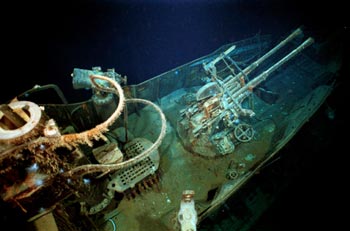
The I-52 rests upright in 17,000 feet of water. Credit: Nauticos LLC..
“We went back over stacks of ship’s logs, war diaries and intelligence reports from 1944,” Jourdan says, “and found the accuracy of their estimates was compromised by many factors. They included bad weather, winds, currents and maneuvers that hindered crews from obtaining good star fixes and accurately updated positions. After reexamining the Navy’s estimated position of the wreck, based on celestial fixes and rough dead-reckoning, we found the records were off target.” That’s when Tidwell, Dettweiler, and search team member Bob Cooke, fueled by Jourdan’s new information, led the expedition to their objective—a tiny cigar-shaped sonar image sitting upright on the bottom.
Tidwell and Nauticos parted after the discovery, the ladder completing a series of successful projects: the discovery and salvage of the Israeli submarine Dakar; managed the Discovery Channel’s live broadcast from the Titanic; discovered wreckage from the WWII Japanese aircraft carrier Kaga; and conducted a search for Amelia Earhart’s lost Lockheed Electra. Jourdan has authored books on the Dakar; the search for the Japanese Fleet: USS Nautilus and the Battle of Midway. His latest, Operation Rising Sun: The sinking of Japan’s Secret submarine I-52, is an engrossing story of a WWII encounter that was almost overlooked in the history of naval warfare.
Tidwell returned in 1998 aboard the Russian scientific research ship, R/V Keldysh, as an advisor to a National Geographic Magazine expedition. An article telling the story of the I-52 appeared in the October, 1999 issue and another one, Searching for Treasure, was published, August, 2011. Some of the subscribers wondered what became of the submarine and its golden treasure. Now, about that two tons of bullion estimated to be worth $25 million in the 1990s and more than $100 million today.
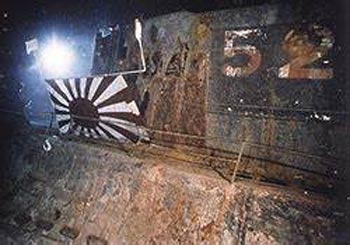
Manipulating controls from the Mir, a Russian submersible, Paul Tidwell placed a Japanese flag on the hull of the I-52. Credit: Paul Tidwell,Photo/Copyright
In all likelihood, it’s still there, possibly stored near the bow. National Archives records revealed this, but as Tidwell explained, “There are some factors involved, such as payment to a former investor and the $8 to $10 million it would cost to launch an expedition. But on the upside, deep ocean technology is much better now and I’ve maintained excellent relations with both the Japanese and U.S. Governments. When we returned some shoes and other artifacts recovered by the Russian Mir submersible on the second expedition, the Japanese were elated. They had a solemn but happy celebration in Kure, Japan, the home of some of the crew and the shipyard where the sub was built and launched.” The citizens of Kure were elated again when told that Tidwell, operating from the Mir, used its manipulators to place a Japanese flag on the hull.
While biding his time, Tidwell is focusing on the story possibly to be featured on the Discovery Channel or one of the other television programs featuring ocean adventures. “The I-52 discovery was akin to walking on the moon,” Tidwell says. “Like the moon walkers, we’ll continue to leave prints of our own using advanced technology and the tools of deep ocean exploration.”
Note: Copies of David Jourdan’s book, Operation Rising Sun: The Sinking of Japan’s Secret Submarine I-52, 290 pgs., 54 illustrations, designs by Bethany Jourdan, published by Potomac Books, Un. of Nebraska Press, 2020, available by ordering from Nauticos, LLC site.
Author: Ellsworth Boyd
Ellsworth Boyd, Professor Emeritus, College of Education, Towson University, Towson, Maryland, pursues an avocation of diving and writing. He has published articles and photo’s in every major dive magazine in the US., Canada, and half a dozen foreign countries. An authority on shipwrecks, Ellsworth has received thousands of letters and e-mails from divers throughout the world who responded to his Wreck Facts column in Sport Diver Magazine. When he’s not writing, or diving, Ellsworth appears as a featured speaker at maritime symposiums in Los Angeles, Houston, Chicago, Ft. Lauderdale, New York and Philadelphia. “Romance & Mystery: Sunken Treasures of the Lost Galleons,” is one of his most popular talks. A pioneer in the sport, Ellsworth was inducted into the International Legends of Diving in 2013.
18 Comments
Submit a Comment
All Rights Reserved © | National Underwater and Marine Agency
All Rights Reserved © | National Underwater and Marine Agency
Web Design by Floyd Dog Design
Web Design by Floyd Dog Design

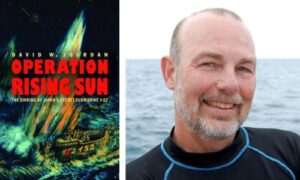
Mr. Boyd, thanks for this article. You have documented a very interesting piece of WW II history and blended it effectively with an account of determined research and successful discovery of a Japanese submarine.
You have sparked “gold fever” within me–only wish I had a start-up fortune to pursue that $100 million in gold!
Thank you for your kind words. Yes, I too have gold fever and I would love to see an expedition launched to go after the precious cargo. It’s quite a story, with intrigue, secrecy and code breaking. If there is an ending, it will be interesting.
I believe we all three have the same mind set after that truly interesting, and entertaining article. I just hope who ever pursues this adventure takes me along too. Could you imagine seeing something so great!
Travis: Thanks for your nice compliment. Yes, wouldn’t it be a thrill to dive on the I-52? However, did you know that it is four hours down in the submersible, then bottom time and then four hours back up? You have to have sea legs too. The research vessel gets into rough waters sometimes. It would however, still be a thrill. Best regards, Ellsworth
A very interesting event in history! Thank you for a well written and fascinating article.
Hi Joanne: Many thanks for your kind words. I’m pleased you liked the I-52 article. This is the sort of real life story where truth is stranger than fiction. I will write more if anything comes of the possibility of treasure salvage on the submarine. Best regards, Ellsworth
Great story for an old diver to read, I have 62 years diving, in military and commercial and would go on this treasure hunt for no compansition. Also have a Navy diver Son with 15 years diving that would be interested. thanks again
Thanks! I’m glad you liked the story. That’s a lot of great experience between you and your son. Why don’t you write to Paul Tidwell and run it by him?
His email is: [email protected]
Enjoyed your updates on the I-52. I was the Director of Photography for the National Geographic Film crew that was aboard the expedition with Paul Tidwell. In addition to the excellent magazine article, our team produced a one hour National Geographic Special, “Search for the Submarine I-52 in 1999.
I remember the first time we came around the conning tower filming and could read the I-52 on its side. Mir-1 with photographer Jonathan Blair was above and behind with their HMI lights shining through the superstructure’s windows. It was a magic moment.
I made the dive with Tidwell later when we placed the Japanese flag on the ship. We filmed the return of the shoe to Kure later in 1999.
THIS IS JUST GREAT! Thanks so much William for sharing your experience. This was the thrill of a lifetime. It was surreal. You were down thousands of feet diving on a World War II enemy submarine that still had its “I-52” identity showing, and then with the light shining through the windows it became even more thrilling and eerie. And then on another dive you helped place the Japanese flag on the wreck. Indeed, a fantastic adventure!
I do hope Mr. Tidwell can get some backing to return to his discovery. Only time will tell.
Herkese selam. Ben Onur. Türkiye’de bir askerim. Hikaye beni çok etkiledi umarım aradığınızı bulabilirsiniz. Sizden bir isteğim var. iyi kalitede ı-52 nin kulesinin fotoğrafını bana yollarmısınız benim için çok önemli. teşekkür ederim.
Can anyone translate this for me? Thanks for your help. Ellsworth Boyd
According to google translate:
“Hello to everyone. I’m Honor. I am a soldier in Turkey. The story impressed me a lot, I hope you find what you are looking for. I have a request from you. Can you send me a photo of the tower of the I-52 in good quality, it is very important to me. thank you.“
Awesome article by the way!
Thanks Rob. I’m glad you liked the article. The only one who might help you is the founder of the submarine, Paul Tidwell.
I have his email as [email protected]. If that doesn’t go through, try: [email protected].
I read the N.G story back in Oct. 1999 and found it truly fasenating. It said they recovered some rubber blocks that floated to the top. Suspecting nuclear atoms on board .Wondering if it will ever be raised.
This delay has been going on for years now. The last I heard was that Mr. Tidwell was conversing with the Javanese government. There is so much red tape involved, I agree with you, wondering if if it will ever be raised.
Where is Howard when you need him ?
Howard Cosell? Ron Howard? Howard the barber on the Andy Griffin show? Howard Duff?
Howard Johnson?